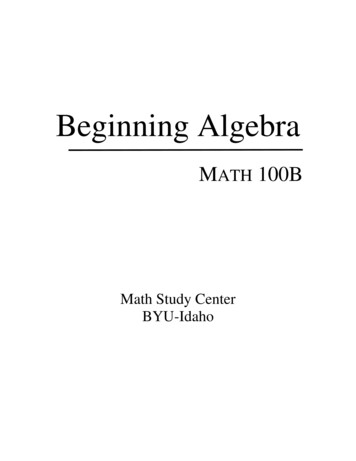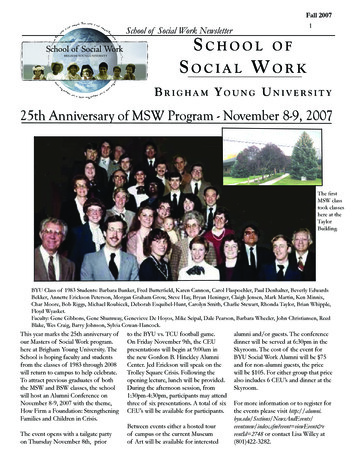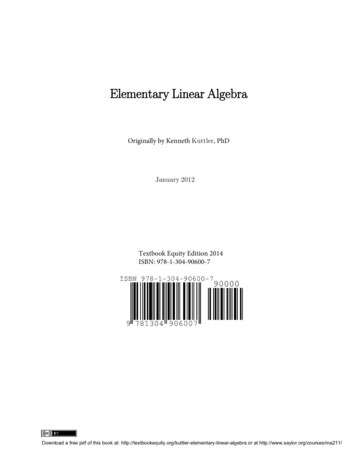
Transcription
Beginning AlgebraMATH 100BMath Study CenterBYU-Idaho
PrefaceThis math book has been created by the BYU-Idaho Math Study Center forthe college student who needs an introduction to Algebra. This book is the productof many years of implementation of an extremely successful Beginning Algebraprogram and includes perspectives and tips from experienced instructors andtutors.Videos of instruction and solutions can be found at the following url:https://youtu.be/-taqTmqALPg?list PL YZ8kB-SJ1v2M-oBKzQWMtKP8UprXu8qThe following individuals have assisted in authoring:Rich LlewellynDaniel BairdDiana WilsonKelly WilsonKenna CampbellRobert ChristensonBrandon DunnHannah ShermanWe hope that it will be helpful to you as you take Algebra this semester.The BYU-Idaho Math Study Center
Math 100BTable of ContentsChapter 1 – Arithmetic and VariablesSection 1.1 – LCM and Factoring . 6Finding factors, Prime Factorization, Least Common MultiplesSection 1.2 – Fractions .14Addition, Subtraction, Multiplication, DivisionSection 1.3 – Decimals, Percents . .21Decimals; Conversion between decimals, fractions, and percents; finding percents of totalsSection 1.4 – Rounding, Estimation, Exponents, Roots, and Order of Operations . 28Natural number exponents and roots of integersSection 1.5 – Variables and Geometry . 39Introductions to variables and their use in formulasSection 1.6 – Negative and Signed Numbers. .51Section 1.7 – Simplifying . 60Combining; Commutative, Associative, and Distributive Properties; Identities and InversesChapter 2 – Linear EquationsSection 2.1 – Linear Equations 79Steps 2 and 3, Addition and Multiplication PrinciplesSection 2.2 – Applications of Linear Equations 91Translation, Shapes, and FormulasSection 2.3 – More Linear Equations .100Step 1, Combining and clearing parenthesesSection 2.4 – Applications of Linear Equations .106Substitution, Consecutive, Percent Word Problems, Forward and BackwardSection 2.5 – Linear Equations with Fractions 117Step 1, Clearing fractions; Summary of 3-step processSection 2.6 – Inequalities .122Greater than, less than symbols, Solving InequalitiesSection 2.7 – Applications of Inequalities .130Inequality translation and Word Problems
Chapter 3 – LinesSection 3.1 – Graphing 144Graphing by Pick ‘n Stick, InterceptsSection 3.2 – Slope .154Section 3.3 – Graphing with slope, Slope-Intercept 161Section 3.4 – Graphing with slope, Standard . 168Section 3.5 – Writing Equations .178Find the Equation of a line given a slope and a point or two pointsChapter 4 – Exponents and PolynomialsSection 4.1 – Laws of Exponents 193Mutliplication, Power, Division, Zero rules for exponents; Scientific Notation ArithmeticSection 4.2 – Intro to Polynomials .202Terminology, Addition and Subtraction of PolynomialsSection 4.3 – Multiplication of Polynomials .211Monomial Polynomials, Special Cases, Binomial Squared, Binomial BinomialSection 4.4 – Division of Polynomials 221Division of Polynomials by MonomialsChapter 5 – FactoringSection 5.1 – Intro to Factoring, Methods 1 and 2 .234Factoring by pulling out GCF, Grouping with 4 termsSection 5.2 – Factoring Trinomials, Method 3 244Factoring Trinomials with lead coefficient 1Section 5.3 – Factoring Trinomials, Method 4 249Factoring Trinomials with lead coefficient 1, ac-methodSection 5.4 – Factoring Special Cases .255Factoring Perfect Squares and Difference of SquaresSection 5.5 – Factoring With All Methods .264Holistic Approach to determine which method to useSection 5.6 – Solving Polynomial Equations .268Zero Multiplication; Solving Polynomial Equations by factoring
5Chapter 1:ARITHMETIC &VARIABLESOVERVIEW1.1 LCM and Factoring1.2 Fractions1.3 Decimals1.4 Exponents, Order of Operations, Rounding1.5 Variables and Formulas1.6 Negatives1.7 Laws of Simplifying
61.1 Factoring and Finding the LCM (Least Common Multiple) AOBJECTIVESKnow how to find the factors of a numberUse factors to find two or more numbers LCMRULES OF ARITHMETIC AND VARIABLES (Overview)Factoring a number means break that number down into numbers that go into it. Finding thedifferent factors of a number can then help us in algebra, adding and subtracting fractions, and manyother things. Finding the LCM is seeing the multiples of two numbers meet. This can be especiallyhelpful for fractions. Throughout this chapter, you will be able to review all of arithmetic and theconcepts and rules of what variables are and how they work.CHAPTER ONE TOPICSLCM AND FACTORINGFind FactorsFind Least CommonMultiples CIMALS e to decimalsChange to fractionsDivisionDivisionROUNDING, ESTIMATION,EXPONENTS, ORDER OFOPERATIONSNearest place value;Round and then computeVARIABLES ANDFORMULASReplace numbers andmake nDivisionLaws of SimplifyingBFACTORINGDEFINITIONS & BASICSPRODUCT: Multiplication of two numbers will get you a productPRIME NUMBER: When a natural number has only two factors, the number 1 and itself.Example: The numbers 3, 5, 7, 11 are primeExample: The number 1 is not a prime number because it does not have two different factors.Section 1.1
7ONE: If two numbers only have the number one as a common factor that means these numbers are“relatively prime”.Example: The numbers 7 and 12 are relatively prime because the only factor they have in common 1.FACTOR: The numbers that are multiplied together to get the product are factors.Example: The factors of 42 are 1, 2, 3, 6, 7, 14, 21, 42 because these are the only natural numbers thatcan multiply to get a product of 42.LCM: Least Common Multiple. You can find this when the multiples of two or more numbers meetup at a common number.Example: The multiples of 8 are 8, 16, 24, 32, 40, 48, and so on. The multiples of 12 are 12, 24, 36, 48,60, and so on. To find the LCM you find the smallest multiple these two numbers have incommon. 8 and 12 both have 24, 48 in common but we are looking for the least commonmultiple, which means the smallest number. Therefore, the LCM is 24 because it is the smallestcommon multiple between 8 and 12.I.Find All FactorsFactoring is a useful and necessary skill when adding and subtracting fractions and will be avery helpful skill to have in algebra.Find Factors1. Start with 1 and move up finding numbers that are factors.2. List the numbers you have found. These are all the factorsEXAMPLESFor factoring number, we simply write down all the numbers that go into it.Number to be FactoredFactors121, 2, 3, 4, 6, 12201, 2, 4, 5, 10, 20271, 3, 9, 27Section 1.1
8EXAMPLESFind all factors of 4811484822448316484124868488648Step 1: Find all factors that multiply to be the product48, starting with the number 1 and 48 and moving up thenumber line.To make them a little easier to see we canput them in numerical order from smallestto largest.1, 2, 3, 4, 6, 8, 12, 16, 24, 48II.Note: In the last box we see 8x6 48. The 8 has alreadybeen used in the factors, so we know that all of thefactors have been found.Step 3: Now we will list all the numbers we used upuntil we saw the repeated number and these will be ourfactors.1, 48, 2, 24, 3, 16, 4, 12, 6, 8Find Prime Factorization of a NumberOnce again, factor each number individually just like we did in the previous example.Prime Factorize1. Find a factor, break the number up.2. Repeat until all factors are prime.EXAMPLESFind the prime factorization of 60 and 72210262 25Step 1: Find the factors of 60 until the factors are allprime.726033626 Step 2: Repeat step one for 7218323 Section 1.1
9Find LCM (Least Common Multiple)EXAMPLE3Multiples of 66121824303642485460Multiples of 44812162024283236404 and 6 have the numbers12, 24, 36, 48 . . .as common multiples.The smallest of these is:12Thus 12 is the LCM(Least Common Multiple)of 4 and 6.Find the LCM (Observation)1. Write out multiples for two or morenumbers2. Find what the two lists have incommon.3. The smallest multiple is the LCMSection 1.1
10EXAMPLE448121620242832Find the LCM of 4 and 5510152025303540Step 1: Write out the multiples for 4 and 5Step 2: The first number that both multiples hit is 20Step 3: The LCM of 4 and 5 is 20.We can also find the LCM of numbers by using prime factorizationEXAMPLE5Prime factorization of 4Prime factorization of 64 2 26 2 32 2 3Prime factorization of the smallest number that both will go in to2 2 3 12Thus 12 is the LCM of 4 and 6Section 1.1
11Find the LCM (Prime Factorization)1. Prime factorize2. Write out the smallest number that theyall can go into.3. Multiply it out LCMEXAMPLE6Find the LCM of 40 and 36.Prime factorization of 40 Prime factorization of 3640 2 2 2 536 2 2 3 32 2 2 3 3 5Prime factorization of the smallest number that both will go in to2 2 2 3 3 5 360Thus 360 is the LCM of 40 and 360Section 1.1
121.1 EXERCISE SETFind the factors for each number1.302. 1503.374.125. 756.81Find the prime factorization of each number.7. 508. 1610. 100279.11. 9912. 13Find the prime factorization of the numbers; then find the least common multiple (LCM).13.3, 814.20, 7515.5, 716.12, 12017.4, 1618.8, 1219.6, 1420.17, 1021.12, 1522.3, 5, 1023.2, 6, 924.4, 8, 10Preparation.After reading some of section 1.2, find the following:25.26. Section 1.1
13Answers1.2.3.4.5.6.7.8.9.10.1, 2, 3, 5, 6, 10, 15, 3023.181, 2, 3, 5, 6, 10, 15, 25, 30, 50, 75, 150 24.401, 3725.In Class.1, 2, 3, 4, 6, 1226.In Class.1, 3, 5, 15, 25, 751, 3, 9, 27, 812 5 52 2 2 23 3 32 2 5 512.3 3 1113.132414.30015.3516.120Still have questions? Videosolutions available: Click here.17.16Or scan:18.2419.4220.17021.6022.3011.
141.2 Arithmetic of Fractions AOBJECTIVESKnow the parts of a fraction and when it is simplified fullyAdd, subtract, multiply, and divide fractionsRULES OF ARITHMETIC AND VARIABLES (Overview)CHAPTER ONE TOPICSLCM AND FACTORINGFind FactorsFind Least lication/DivisionDECIMALS e to decimalsChange to fractionsROUNDING,ESTIMATION,EXPONENTS, ORDER OFOPERATIONSVARIABLES ANDFORMULASNEGATIVESDivisionNearest place value;Round and then computeReplace numbers andmake Laws of SimplifyingBARITHMETIC OF FRACTIONSDEFINITIONS & BASICSNUMERATOR: The top of a fraction. This is always an integer, never a decimal.DENOMINATOR: The bottom of the fraction. This is always an integer, never a decimal,23and never zero.SIMPLIFY: Fractions are simplified when the numerator and denominator have no factors incommon. You can also say that the fraction is reduced. Example: The fraction can be simplified or reduced down to .ONE: Any number divided by itself is 1.Section 1.2
15COMMON DENOMINATORS: Addition and subtraction require like things. In the case offractions, “like things” means common denominators. Example: You cannot add (2 thirds) and (1 sixth) because they are not like things. In order to addthem, they must have common denominators. It’s okay to multiply by because 1, and there’s no harm inmultiplying anything by 1!You can find common denominators in three main ways:1) Simple observation, as in the above example. You can clearly see that 6 is a possible commondenominator.2) Multiply the two denominators together. In the above example, that would result in a commondenominator of 18, which would still give you the right answer, but you would be dealing withlarger numbers.3) Use prime factorization to find the least common denominator.LEAST COMMON DENOMINATOR (LCD): As the name indicates, this is the lowestpossible common denominator between two or more fractions. There are an infinite number ofpossible common denominators, but usually the easiest one to choose is the lowest or least one. Example: Consider the fractions and . There are many numbers that could work as commondenominators, but we can use prime factorization to find the least common denominator. We willfind the prime factorization of each denominator, and compare then to find a common one.642223The prime factorization for 4 is 2 2, and for 6 it is 2 3. For the LCD, weneed a number that has each of these prime factors in it. However, we onlyneed two 2’s because 2 is repeated in the prime factorization of each ofthese numbers. The LCD is number whose prime factorization is 2 2 3,which is 12.*The number found for the LCD is also called the LCM: Least Common Multiple. The only differenceis that the LCM might not be used as the denominator of a fraction.I.Addition of FractionsAdding fractions is another way of adding “like things.” We have to make all the fractionshave a common denominator, and then they can be added.Addition and Subtraction of Fractions1. Get a common denominator between the fractions1. Observation2. Add the numerators2. Multiply the denominators3. Prime factorizationSection 1.2
16EXAMPLES Add1 Step 1: Common denominator. If we multiply thedenominator here, we’ll have some big numbers to workwith. Let’s use prime factorization to find the LCD. 3063 125222 Prime factorization of 30: 2 3 5Prime factorization of 24: 2 2 3We need a number whose factors include each of these:2 2 3 5 6034 26 35 6160 60Step 2: Now that the denominators are the same, add thenumerators. Answer: EXAMPLES2Subtract 5 3 2 9 9 9The common denominator is 9, so change the to a . Subtract the numerators.Answer:Section 1.2
17II.Multiplication of FractionsWhen multiplying fractions, common denominators are not needed. This is different fromaddition and subtraction.Multiplication of Fractions1. No common denominators2. Multiply numerators3. Multiply denominatorsEXAMPLES3Multiply ? # For multiplication don’t worry about getting commondenominators Multiply the numerators straight acrossMultiply the denominators straight acrossAnswer: III. Division of FractionsDividing fractions is an interesting idea, because a fraction itself is a division (i.e. ½ can alsobe said as 1 divided by 2). Because of this, there is a special process for dividing fractionsthat actually simplifies it. To divide a number by a fraction, reciprocate the fraction andmultiply instead. Now you’re doing a multiplication problem, one you already know how todo.Division of Fractions1. Change any fractions into improper fractions.2. Keep the first fraction the same, change the division sign tomultiplication, and flip the second fraction’s numerator anddenominator: Keep it, change it, flip it.3. Multiply straight across.Section 1.2
18EXAMPLES Divide4 % %%Step 1: Turn the fractions into improper fractions Step 2: Keep the first fraction the sameChange the division sign to a multiplication signFlip the second fraction’s numerator and denominator Step 3: Multiply straight across the numerator and denominatorAnswer: Divide % 5 % Turn the fractions into improper fractions 2 7%5 42 4 5 7 # Keep the first fraction the sameChange the division sign to a multiplication signFlip the second fraction’s numerator and denominatorMultiply straight across the numerator and denominatorAnswer: IV. USE OF CALCULATORAfter learning to do these by hand, and practicing a few of them, you should learn to use a calculatorto do the problems as well. Most scientific calculators have a key that will allow you to input fractionsas well as receive the answer as a fraction as well. Have your teacher or a tutor point out whichparticular buttons on your calculator are for fractions; then practice it.Section 1.2
191.2 EXERCISE SETFind Factors.1. 162. 481.1Find the prime factorization.4. 605.3.6.630Find the least common multiple (LCM).9.8. 3 & 138 & 2212.108 & 3213.10.1107.22521011. 35 & 216&71500 & 18014. If two planets are aligned with the sun and one planet goes around the sun every 12 years and theother planet takes 22 years, how long will it be before they are in alignment again?Add by hand.15.1.2 16. 8 17. # Subtract by hand.18. 19.3 1 20. Multiply by hand.21. 3 22. 23. #Divide by hand.24. % Solve and simplify with calculator.27. 30. # 25. 28. %626. 11 112 2129. 31. 34. 37. % 33. 36. % 32. % 35. 38. % Preparation.After reading some of section 1.3, find the following:39. 21.34 12.01 34.2 18 40. . 04 .26 48.2 % 1.6 # 72.1 11.03 10.4 4.9 9.3 4.1 4.4 % 2.2 Section 1.2
20Answers 1.1, 2, 4, 8, 1623.2.1, 2, 3, 4, 6, 8, 12, 16, 24, 4824.3.1, 2, 5, 10, 11, 22, 55, 11025.4.2 2 3 526.5.2 3 3 5 727. 6.3 3 5 528. 7.2 3 5 729.# 8.3930. 9.8831. # 10.4232. 11.10533. 12.86434. 13.450035. 14.132 years36. 37. 38. #39.In Class.40.In Class.15.16.17. or 118. #19.,or2-.20. 21.22. Still have questions? Videosolutions available: Click here.Or scan: Section 1.2
211.3 Arithmetic of Positive Decimals and Percents AOBJECTIVESIntroduce “simplify” type problemsLearn the basics of variablesAdd, subtract, multiply, and divide with decimalsConvert percents to decimals & fractions and vice versaSolve percent problems with “of”RULES OF ARITHMETIC AND VARIABLES (Overview)Numbers are everywhere. The rules they follow help us to know how to govern bank accounts,build buildings, and predict orbits of planets. We use them to measure heights, lengths, and amounts ofeverything. Mastery of these rules is necessary to understand everything that goes on around us.CHAPTER ONE TOPICSLCM AND FACTORINGFind FactorsFind Least licationDECIMALS e to decimalsChange to fractionsDivisionROUNDING, ESTIMATION,EXPONENTS, ORDER OFOPERATIONSNearest place value;Round and then computeVARIABLES ANDFORMULASReplace numbers andmake nDivisionLaws of SimplifyingEXAMPLESWe will learn how to handle and feel comfortable in all of these situations.ArithmeticWhat kind of problemWhere it might be found 30.00 – 22.73Decimal SubtractionFinding change at the store3 Fraction multiplicationTripling a recipe6% of 18Finding percentsSales tax on an 18 shirt7 3.59Decimal multiplicationThe total price of 7 items at 3.59 each Section 1.3
22Important Note: We do not need like things for multiplication and division.BARITHMETIC OF DECIMALSDEFINITIONS & BASICSPLACE VALUES: Every place on the left or right of the decimal holds a certain value. To the leftof the decimal, the values are ones, tens, hundreds, thousands, and so forth. On the right of the decimal,the place values are tenths, hundredths, thousands, and so forth.3 ,4 5 1 . 9 7 2thousandshundreds tensonestenths hundredthsthousandthsIn this example, there are 3 thousands, 4 hundreds, 5 tens, 1 one, 9 tenths, 7 hundredths, and 2thousandths.DECIMAL: Deci- is a prefix meaning 10. Since every place value is either 10 times larger or smallerthan the place next to it, we call each place a decimal place.LAWS & PROCESSESSince this course is built on the assumption that you have a calculator and is focused on teachingyou Algebra, we will summarize the laws and processes of the arithmetic of decimals by requesting thatyou become familiar with the uses of your calculator.CPERCENTAGESDEFINITIONS & BASICSPercents are such a huge part of our society, what with sales tax, income tax, discounts, sales,etc. They are everywhere. They are really just another way of writing fractions or decimals!PERCENT: Percent can be broken up into two words: “per” and “cent” meaning per hundred, or inother words, hundredths.Example:7 .07 7%10031 .31 31%10053 .53 53%100Notice the shortcut from decimal to percents: move the decimal to the right two places.Section 1.3
23I.Converting PercentsConverting Percents1. If it is a fraction, divide to get decimal2. Move decimal 2 places3. “OF” means timesEXAMPLESFraction1334751Calculator1 3DecimalPercent0.3333%0.7575%1.40140%3 47 5Convert .25 to percentsMove the decimal two places to the right because we are turning.25 25%this into a percentAnswer: 25%2What is as a percent? Turn the fraction into a decimal by dividing5 32 .15625. 15625 15.625%3II.Move the decimal two places to the right because we areturning this into a percentAnswer: . %Convert 124% to decimals124% 1.24Move the decimal two places to the left because we are turningthis into a decimalAnswer: 1.24Solving Percent Problems with “of”Section 1.3
24Percents always are a percent of something. For example, sales tax is about 6% or 7% of yourpurchase. Since this is so common, we need to know how to figure this.If you buy 25 worth of food and the sales tax is 7%, then the actual tax is 7% of 25.07 25 1.75In math termsthe word “of”means times.Solving Percent Problems with “of”1. Turn percent into a decimal2. Multiply the two numbers togetherEXAMPLES4What is 25% of 64?25% .25. 25 64 165What is 13% of 25?13% .13. 13 25 3.25Turn the percent into a decimalMultiply the two numbers togetherAnswer: 16Turn the percent into a decimalMultiply the two numbers togetherAnswer: 3.25Section 1.3
256What is 30% of 90 feet?30% .30Turn the percent into a decimal. 30 90 27Multiply the two numbers togetherAnswer: 27 feetCOMMON MISTAKESThe most important thing that you should know about percents is that they never stand alone. If I wereto call out that I owned 35%, the immediate response is, “35% of what?” The response should comewith 35% of something, which means that you will multiply:. 35 !"Section 1.3
261.3 EXERCISE SETPerform the indicated operation.1.11.LCM of 8,52.LCM of 2,133.LCM of 9,114.LCM of 12,205.Factors of 566.Factors of 807.Factors of 1448.Factors of 369.Factors of 31%11.'&&( 12.&#)* )14.)'&15.&)& #Find the prime factorization or LCM if indicated.16. 10517. 22418.LCM (108, 36)Perform the indicated operation.19. 186.4 57.0621.23.58.93(17.9865,968.4 924.2,578 389.40.07 0.00626. 045%27.2.1%30.47% of 47Perform the indicated operation.1.210. #13.) ) &# 1.322.365.8 0.5Convert to decimal notation.25. 92.4%20.) Evaluate.28.15% of 2629.80% of 29431.63% of 2,43632.9% of 50Change these fractions into decimals and percents.33. %34.)35.'& &-Find the final.36.Price: 365.29Discount: 79Final:37. Temp.: 39 FWarmer: 23 FFinal:38.Altitude: 2,349 ftRise: 821 ftFinal:Preparation. Read section 1.4 and do the following:40. Round to the nearest tenth.4895.248956. 0895452148621.222241. Write in Exponential Notation and Evaluate.8 8 82 2 2 2539. Debt: 2,000Income: 487Final:9965.0317 17Section 1.3
.18.19.20.21.4022.9924.1, 2, 4, 7, 8, 14, 28, 5626.1, 2, 3, 4, 6, 8, 9, 12, 16, 18, 24, 36, 48, 72, 14428.1, 3130.2623.6025.1, 2, 4, 5, 8, 10, 16, 20, 40, 8027.1, 2, 3, 4, 6, 9, 12, 18, 3629.10711931.53332.332011875663.15611.667. 924. 00045. 0213.9235.222.091534.684.534. 37535.87533.98182.936.3 5 737.10840.94437.5%. 2 22.2%87.5% 286.2962 F25 738.39.3,170 ft243.4640. 1,513, or 1513 in debtIn class41.In class2,967.4Still have questions? Videosolutions available: Click here.Or scan:
281.4 Rounding, Estimation, Exponents, Roots, and Order of Operations AOBJECTIVESRound numbers to a specified place (i.e. hundreds, tenths, etc.)Estimate products by roundingUse inequalities to express estimatesFind absolute values of numbersUse the order of operations to simplify expressionsUnderstand exponents and square rootsREVIEW OF ARITHMETIC AND VARIABLES (Overview)Simplification is a useful principle; it helps us write things in smaller or shorter ways withoutchanging the value. We used fractions sometimes in order to represent parts in a simpler way than a decimal (remember ?). Sometimes it gets to be a hassle to write long multiplication problems, just as itwas to write long addition problems.Now that you have finished arithmetic, and you have seen how some problems may get long andtedious, you may understand why some folks choose to estimate and round numbers.LAWS & PROCESSESCHAPTER ONE TOPICSLCM AND FACTORINGFind FactorsFind Least licationDECIMALS e to decimalsChange to fractionsDivisionROUNDING, ESTIMATION,EXPONENTS, ORDER OFOPERATIONSNearest place value;Round and then computeVARIABLES ANDFORMULASReplace numbers andmake nDivisionLaws of SimplifyingSection 1.4
29EXAMPLESAbout how many dollars will you have if you start with 15,474, take 48% of it, and thensubtract off 155 to pay a bill, and then receive 49?1 15,472 15,50048% is .48.50so 15,500x.50 7750.00 7750 155 49 RoundingEstimationOrder of Operations 7750 155 7595 49 7644Rounding 7600Answer:B ROUNDING AND ESTIMATION; ORDER OF OPERATIONSDEFINITIONS & BASICSROUNDING: In rounding, we decide to not keep the exact number that someone gave us. Forexample:If I have 528.37 in the bank, I might easily say that I have about 500. I have justrounded to the nearest hundred.On the other hand, I might be a little more specific and say that I have about (still notexact) 530. I have just rounded to the nearest ten.ESTIMATION: Once rounding is understood, it can be used as a great tool to make sure that wehave not missed something major in our computations. If we have a problem like:3,427,000 87.3We could see about where the answer is if we estimate first:Round each number to the greatest value you can3,000,000 90and our answer will be around 270,000,000We should note that the real answer is: 299,177,100 but the estimation will let us know thatwe are in the right ball park. It ensures that our answer makes sense.Section 1.4
30INEQUALITIES: You know how an equal sign works – it is placed between two things that meanthe same thing. If you wanted to show that two things were not equal, you would use an inequality:Symbols of Inequalities Greater than Less than Less than or equal to Great than or equal toThe symbol always points to the smaller number. You can also remember that the two lines are fartherapart on the BIGGER side, and close together on the smaller side, so the distances between the two linesis related to how big the number is.BIGGERsmallerEach symbol can be flipped around as long as the numbers on either side are also flipped around. Forexample, 7 -4 and -4 7 mean the same thing, and -4 is always on the small side of the sign.ABSOLUTE VALUE: Another symbol to be aware of is the absolute value symbol. To find the“absolute value” means to find out how far away from zero a number is, like on a number line. Forexample, the number 5 is 5 units away from zero. The number -5 is also five units away from zero (justin the opposite direction).Examples: 13 13 -9 9 -43 43P.E.M.D.A.S.: An acronym to help remember the order of doing things.P parenthesisE exponentsM.D. multiplication and divisionA.S. addition and subtractionI.RoundingThese are grouped like this becausethey are so similar they should bedone at the same time.EXAMPLES2Round 4,278.23 to the nearest hundred 4,300.00Decide if our number is closer to the nearest 4,278.23hundred above the number or below the number 4,200.00Change our number to the one it is closer to 4,278.23 4,300.00Answer: 4,300.00Section 1.4
31II.EstimationEstimation1. Round to the highest value2. Do the easy problemEXAMPLES3Multiply by rounding: . . 986.7 1,0004.9 51,000 5 5,000986.7 4.9 5,000Round the numbersMultiply the rounded numbers togetherOur answer for 986.7 4.9 will be around 5,000Answer: 5,000III.InequalitiesEXAMPLES4IV.Write an equivalent expression: 38 1438 1414 38 Flip the sign and the numbersAnswer: 14 38Absolute ValueEXAMPLES5Find the absolute value of the following: 8, -16, 8 8 -16 16 Answer: 8, 16,Section 1.4
32EXPONENTS, ROOTSCDEFINITIONS & BASICS2!What does this mean?Is it the same as 2 x 4?Does it equal 8 ?When we see a little number next to a big number, it looks difficult, challenging, but it’s not it’s just aSHORTCUT.The little number next to the big number is called anEXPONENT.(other names for exponents are POWER or DEGREE)2! means 2 2 2 2 four two’s all being multipliedSay the following out loud “3 3 3 3 3 3 3 3 3 3”How many three’s are there? Now say “310” or “three to the tenth”Which sounds easier?Hence, EXPONENTS are SHORTCUTS!EXPONENT/POWER: The shorthand to explain how many times something is multiplied byitself.Example:2 2 2 2 2 2 2 128 is the same as 2" 1287ROOT: Like working an exponent backwards, roots find out what number or variable was raised to apower.Example: We know that 27 128, so to work it backwards, we say: 2 128or if 128 was cut into 7 equal parts multipliedtogether, then those parts would all be 2’s.We can use these “shortcuts” with variables or numbers, for example:% · % · % · % · % % ' just as 2 2 2 2 2 2'How do we say it?Section 1.4
33x5 “x to the fifth”24 “two to the fourth”The Three E’s of ExponentsExponential Notation1222232425Expanded NotationE
very helpful skill to have in algebra. For factoring number, we simply write down all the numbers that go into it. Number to be Factored Factors . 12 1,2,3,4,6,12 20 1,2,4,5,10,20 27 1,3,9,27. Find Factors . 1. Start with 1 and move up finding numbers that are factors. 2. List the numbers you have found. These are all the factors EXAMPLES 7











